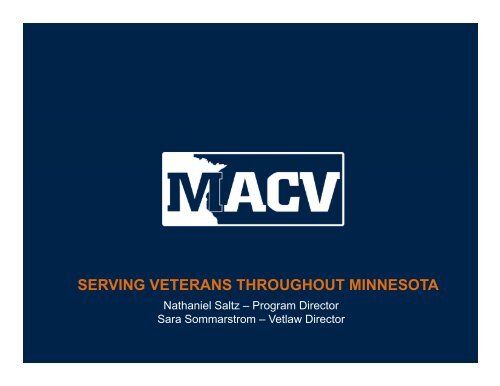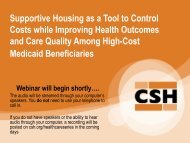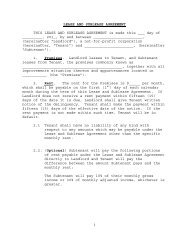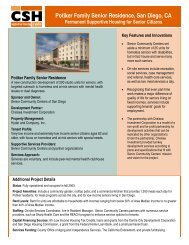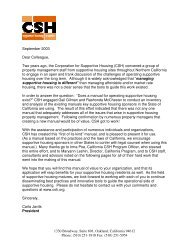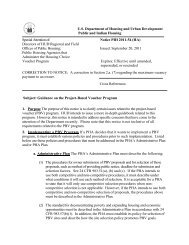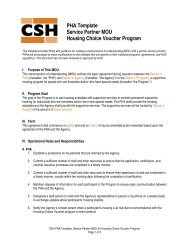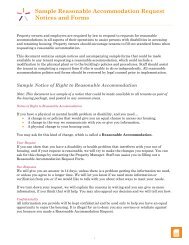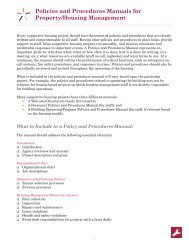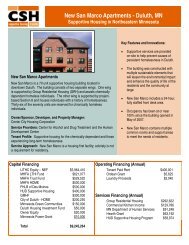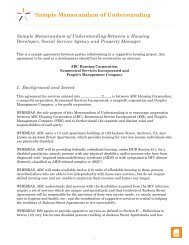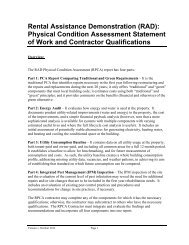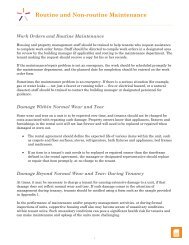Homelessness Among Veterans - Corporation for Supportive Housing
Homelessness Among Veterans - Corporation for Supportive Housing
Homelessness Among Veterans - Corporation for Supportive Housing
You also want an ePaper? Increase the reach of your titles
YUMPU automatically turns print PDFs into web optimized ePapers that Google loves.
SERVING VETERANS THROUGHOUT MINNESOTA<br />
Nathaniel Saltz – Program Director<br />
Sara Sommarstrom – Vetlaw Director
Ending <strong>Homelessness</strong> <strong>Among</strong><br />
<strong>Veterans</strong>
A VETERAN<br />
DEFINED….<br />
Principled Uprightness of Character<br />
Principled Uprightness of Character<br />
Personal Integrity<br />
Honor<br />
Sacrifice
MACV Mission: To provide assistance throughout<br />
Minnesota to positively motivated veterans and their<br />
families who are homeless or experiencing other life crises.<br />
MACV accomplishes this by providing direct services or by<br />
collaborating with other agencies/providers.<br />
MACV Vision To be an enthusiastic, proactive<br />
champion and national leader creating and supporting<br />
alliances and partnerships to assist veterans who are<br />
threatened with or experiencing homelessness.
About MACV<br />
501(c)(3) Nonprofit<br />
Established 1990<br />
Operates 3 Regional Offices <strong>for</strong><br />
statewide outreach: Mankato, Duluth,<br />
and the Twin Cities Metro;<br />
Headquarters in St. Paul.<br />
Certified by Minnesota Charities<br />
Review Council &<br />
Better Business Bureau<br />
Audited ANNUALLY and throughout<br />
the year by specific funders
MACV Locations:<br />
St. Paul Headquarters:<br />
360 Robert Street North<br />
Suite 306<br />
St. Paul, MN 55101<br />
MACV-Duluth<br />
5209 Ramsey Street<br />
Duluth, MN 55807<br />
MACV-Metro:<br />
One <strong>Veterans</strong> Drive<br />
VAHCS Building 47<br />
Minneapolis, MN 55417<br />
MACV-Mankato<br />
12 Civic Center Plaza, Suite 1615<br />
Mankato, MN 56011
VA BENEFITS<br />
Health Care<br />
Research<br />
Disabilities and Pensions<br />
Home Loan Guarantees<br />
Memorial Affairs<br />
– National Cemetery<br />
VETERANS ADMINISTRATION<br />
VHA –<strong>Veterans</strong> Health Care<br />
VBA –<strong>Veterans</strong> Benefits
MILITARY AND VETERANS<br />
NO SAFE PLACE – NO SAFE ROLE<br />
Operation Enduring Freedom (OEF)<br />
Operation Iraqi Freedom (OIF)<br />
Operation New Dawn (OND)
National Findings (OEF/OIF)<br />
Approximately 1.7 million have deployed since 2001<br />
34% have deployed multiple times<br />
28% are National Guard or Reservists (average age is 36 years old)<br />
46% of Regular Forces are under 25 years old; <strong>for</strong> many this is the first<br />
time they have left home<br />
Approximately 895,000 OEF/OIF veterans are separated from the military<br />
and ELIGIBLE <strong>for</strong> VA services<br />
MILITARY AND VETERANS
Roughly one in every 5 suffer from a major depression or PTSD, estimated<br />
at 300,000. Only half have sought treatment.<br />
As many or more report possible brain injuries i from explosions or other<br />
head wounds. An estimated 50%–60% of spouses of TBI patients suffer<br />
depression.<br />
Roughly 50% have spouses and children<br />
Reasons <strong>for</strong> not seeking help were cited as concern over side effects of<br />
medication, they believed family and friends would help, or they feared seeking<br />
might damage their military careers.<br />
National Findings (OEF/OIF) Continued…<br />
MILITARY AND VETERANS
Studies have found that veterans returning from<br />
combat are 63% more likely to report new-onset heavy<br />
drinking than those not deployed to combat zones;<br />
young veterans had the highest risk <strong>for</strong> developing<br />
alcohol-related problems.<br />
Alcohol is commonly used as a coping mechanism after traumatic events.<br />
National Findings (OEF/OIF) Continued…<br />
MILITARY AND VETERANS
Women in the Military<br />
An estimated 180,000 OEF/OIF veterans are women<br />
According to the DoD in 2010, more than 30,000<br />
single mothers have deployed to Iraq & Afghanistan.<br />
Women now make up:<br />
15% of active duty military<br />
17% of National Guard/Reserves<br />
20% of New Recruits<br />
MILITARY AND VETERANS
390,000 <strong>Veterans</strong> Live in Minnesota<br />
MN is 21st in population; 5 th in size of National Guard<br />
MN Army Air National Guard has been in over 33 countries<br />
in the last 5 years<br />
National Findings (OEF/OIF) Continued…<br />
MILITARY AND VETERANS
974 Water Towers in Minnesota……<br />
585 have deployed service<br />
personnel in OEF/OIF
NATIONAL GUARD LOCATIONS<br />
25 & DOWN<br />
26‐75 PAX<br />
76 & UP
20–25% of the veterans recently back<br />
from tours of duty are UNEMPLOYED.<br />
Of those employed since leaving the<br />
military, 25% earn less than $21,840<br />
year.<br />
Source: Department of <strong>Veterans</strong> Affairs survey of 1941 veterans
Leading Cause of death of<br />
returned veterans: MOTORCYCLES<br />
O C
In the Headlines<br />
“Long Iraq Tours Make Home a Trying<br />
Front”<br />
“Battle Worn”<br />
“When Troops Bring the War Home”<br />
“Hundreds d of Iraq Vets are Homeless”<br />
“Treating War’s Toll on the Mind”<br />
“For Troops, Stress a Lingering i Hazard”
Unique injuries and mental<br />
health hissues among veterans returning<br />
from Iraq and Afghanistan<br />
• TBI - increasing evidence that combat-related TBI are a frequent occurrence.<br />
One half of all injuries are TBI due to explosion (mostly mild). Most common<br />
physical injury.<br />
• PTSD - the VA defined PTSD as a type of anxiety that affects people who’ve<br />
experienced a particular traumatic event that creates intense fear,<br />
helplessness l or horror. 20% (one of five) of Iraq veterans (seeking help) have<br />
PTSD with women suffering more pronounced and debilitating <strong>for</strong>ms of PTSD.<br />
• SUD – includes both abuse and dependence of alcohol and drugs. SUD can<br />
create or exacerbate problems <strong>for</strong> homeless veterans looking <strong>for</strong> work or<br />
starting new jobs. On the other hand, employment can provide a powerful<br />
motivator <strong>for</strong> people to re-examine their behaviors related to substances.
HOMELESSNESS
<strong>Homelessness</strong> <strong>Among</strong> <strong>Veterans</strong><br />
National Statistics<br />
Estimated more than 67,000 homeless veterans on any<br />
given night (NCHV) VA estimates it can only meet 20% of<br />
the need. The other 80% is up to community based<br />
organizations.<br />
23% of all homeless are veterans<br />
33% of all homeless men are veterans
Statistics Provide Typical<br />
Profile of a Homeless Veteran<br />
• Typical homeless Veteran is male, single,<br />
most come from poor, disadvantaged<br />
communities, 45% suffer from mental illness,<br />
and 50% have substance abuse problems.<br />
More than 67% served our country <strong>for</strong> at<br />
least three years.<br />
• http://www1.va.gov/homeless/<br />
/ /
An estimated 6500 female veterans are currently homeless<br />
In this country and the number is expected to continue to<br />
rise (5% of total homeless veteran population)<br />
A female veteran is four times more likely to be homeless<br />
than a female civilian<br />
One out of 10 homeless veterans under the age of 45 is<br />
now a woman<br />
National Statistics Continued….<br />
…<br />
HOMELESSNESS AMONG VETERANS
Female <strong>Veterans</strong><br />
Unlike their male counterparts, many have the added<br />
burden of being single parents<br />
Although 15% of the military is female, only 8 of 260<br />
programs in the National Coalition <strong>for</strong> Homeless <strong>Veterans</strong><br />
network offer services specifically <strong>for</strong> women<br />
VA recently authorized new funding to target elderly,<br />
female, and mentally-disabled veterans<br />
National Statistics Continued….<br />
…<br />
HOMELESSNESS AMONG VETERANS
“The $15,000 that t <strong>for</strong>mer Army<br />
Private Margaret O. had in the bank<br />
when she left Iraq is long gone,<br />
spent on alcohol l and cocaine.”<br />
National Statistics Continued…<br />
HOMELESSNESS AMONG VETERANS
Approximately 390,000 veterans in MN (23,000 female); approx. 100,000 are<br />
getting VA Health Care, but another 70,000 are eligible (<strong>for</strong> female veterans<br />
only 1500 are connected to the VA)<br />
Estimated that over 4000 are homeless or at risk of becoming homeless<br />
at some point in the year<br />
669 veterans are homeless on any given night; (250 in the Metro area)<br />
1 in 4 homeless men are veterans<br />
<strong>Veterans</strong> represent approx. 13% of the total homeless population (1 in 8)<br />
32% of homeless veterans have served in a combat zone<br />
Source: Wilder Research 2009 Statewide Survey of Homeless <strong>Veterans</strong> in Minnesota<br />
Minnesota Statistics Continued….<br />
…<br />
HOMELESSNESS AMONG VETERANS
13% of homeless adults are veterans •<br />
24% of homeless men are veterans<br />
89% received an honorable discharge<br />
95% completed HS/GED compared to 74% of general homeless pop.<br />
60% serious mental illness<br />
70% suffer from substance abuse problems<br />
46% are age 45 or older<br />
31% dual diagnosis<br />
52% chronic health condition<br />
27% (47% of combat <strong>Veterans</strong>) have PTSD<br />
Minnesota Statistics Continued….<br />
…<br />
HOMELESSNESS AMONG VETERANS
Homeless <strong>Veterans</strong> by County/Region<br />
13% of Homeless Adults are <strong>Veterans</strong> Statewide<br />
Metro Area:<br />
2% Anoka<br />
7% Dakota<br />
13% Hennepin*<br />
14% Ramsey<br />
3% Scott/Carver<br />
2% Washington<br />
Greater Minnesota:<br />
24% Central<br />
13% Northeast<br />
8% Northwest<br />
10% Southeast<br />
10% Southwest<br />
14% St. Louis County<br />
17% West Central<br />
*Minneapolis –250 homeless veterans on any given night<br />
Minnesota Statistics Continued….<br />
…<br />
HOMELESSNESS AMONG VETERANS
MN Veteran <strong>Homelessness</strong> Statistics<br />
<strong>Veterans</strong> were older than non-veteran homeless men<br />
95% of homeless veterans had a high school degree<br />
1/3 reported alcohol/drug abuse<br />
60% reported a serious mental illness<br />
52% had a chronic health condition<br />
Source: Wilder Research 2009 Statewide Survey of Homeless <strong>Veterans</strong> in Minnesota<br />
Minnesota Statistics Continued….<br />
…<br />
HOMELESSNESS AMONG VETERANS
Af<strong>for</strong>dable <strong>Housing</strong> National Statistics<br />
HUD released a report to Congress in 2010 that stated households with ‘worst<br />
case’ housing needs increased 6% between 2009- 2010. ‘Worst case’ is<br />
defined as using more than 50% of their monthly income <strong>for</strong> rent or living in<br />
substandard housing (severely cost-burdened households).<br />
In 2010, there were 6.2 million households with ‘worst case’ needs.<br />
Only 77 out of 100 very low income units were available and only 40 out of 100<br />
extremely low income units were available.<br />
HOMELESSNESS AMONG VETERANS
A single parent with one child in Hennepin County would<br />
need $19.57/hour to cover monthly expenses<br />
If they make $12.95 they would not be eligible <strong>for</strong> MFIP,<br />
Food Stamps, free/reduced lunch, Child Care Assistance,<br />
or WIC.<br />
SO… if they earn between $12.95 and $19.57, they are not eligible <strong>for</strong><br />
services/programs AND they are not making a living wage.<br />
Source: All expense data from JOBS NOW Coalition 2009<br />
Minnesota Af<strong>for</strong>dable <strong>Housing</strong> Statistics Continued….<br />
…<br />
HOMELESSNESS AMONG VETERANS
Homeless <strong>Veterans</strong> Need…<br />
A coordinated ef<strong>for</strong>t that provides secure housing, food,<br />
essential physical health care, substance abuse aftercare,<br />
mental health counseling, and employment assistance.<br />
employment = housing = empowerment<br />
HOPE IS NOT A STRATEGY
Homeless <strong>Veterans</strong> Need…<br />
According to the National Coalition <strong>for</strong> Homeless <strong>Veterans</strong>,<br />
cost effective programs are community-based, nonprofit,<br />
‘veterans helping veterans’ groups.<br />
Programs that seem to work feature transitional housing<br />
settings that offer living in a structured, substance-free<br />
environment with fellow veterans.<br />
HOMELESSNESS AMONG VETERANS
Homeless <strong>Veterans</strong> Need…<br />
Community based homeless veteran service providers are<br />
most successful when they work in collaboration with<br />
federal, state, and local government agencies and veteran<br />
service organizations.<br />
www.nchv.org<br />
HOMELESSNESS AMONG VETERANS
MACV PROGRAMS
MACV 2011 STATISTICS<br />
Close to 25,000 contacts annually<br />
In 2011, we assisted over 967 veterans and their families<br />
with direct services; a 58% increase over 2007.<br />
Female <strong>Veterans</strong>: 7% and rising<br />
<strong>Veterans</strong> with a Disability: 65%<br />
OIF/OEF <strong>Veterans</strong>: 27% and rising<br />
MACV PROGRAMS
Services: Intensive case management, and other<br />
supportive services such as training, i education, etc.<br />
Assistance: Direct assistance including short-term rent<br />
assistance, security deposits, mortgage assistance, utility<br />
assistance, transportation assistance, food vouchers, etc.<br />
MACV PROGRAMS
MDVA & CVSO PARTNERSHIPS<br />
In our attempt to not duplicate any service already available<br />
to a veteran, we make sure a referral is made to the CVSO<br />
(County <strong>Veterans</strong> Service Officer) in order that the veteran<br />
can be assessed <strong>for</strong> eligibility in county/state programs<br />
such as:<br />
State Soldiers Assistance Program, Special Needs, Dental<br />
and Eye Care, Education Benefits
MACV Funding Sources<br />
Program Fees from the Veteran Participants<br />
Federal VA Grant & Per Diem – Building 47<br />
State Grants MN Dept of Veteran Affairs, Office of Economic Opportunity<br />
Federal Grants DOL HVRP, HUD, SSVF, EFSP, ESG/CDBG<br />
Donations (Unrestricted & Restricted) – Foundations, Corporate Giving, Individuals<br />
Fundraising Events and Campaigns<br />
MACV PROGRAMS
Eligibility <strong>for</strong> Services<br />
Veteran status verified – DD214 -181 days Active Duty Service<br />
Homeless Status (some programs)<br />
Prevention (some programs)<br />
Financial need and meet specific program guidelines<br />
Minnesota Resident 30 days (most programs)<br />
Must be positively motivated to make a change<br />
MACV PROGRAMS
What We Assess with the Veteran<br />
<strong>Housing</strong> Status<br />
Health Status, mental & chemical<br />
Medical Problems<br />
Employment & Income Status<br />
Appropriate <strong>Housing</strong><br />
Living Skills<br />
Eye & Dental Care<br />
Legal Issues<br />
MACV PROGRAMS
What We Provide…<br />
Transitional & Permanent <strong>Housing</strong> with <strong>Supportive</strong> Services<br />
Eviction Prevention<br />
Mortgage Foreclosures<br />
Utility Payments<br />
Transportation Bus passes Gas Cards<br />
Food Vouchers<br />
Clothing Vouchers<br />
Employment Assistance<br />
Tax & Legal Referrals<br />
Case Management<br />
Network of Providers <strong>for</strong> Referrals<br />
MACV PROGRAMS
Desired Outcomes<br />
Placement in appropriate housing<br />
Increased level of life/living skills<br />
Increased level of income<br />
Increased level of financial responsibility<br />
Increased level of health (mental & physical)<br />
Increased level of responsibility and connection to the community<br />
Increased ability to interact in relationships<br />
MACV PROGRAMS
MACV – HQ<br />
Kathleen Vitalis – President/CEO: 651.291.8756<br />
Cari Canning<br />
Nathaniel Saltz<br />
Sara Sommarstrom<br />
Rebecca Geragi<br />
Chief Operating Officer<br />
Program Director<br />
Vetlaw Director<br />
Operations Administrator<br />
MACV PROGRAMS
MACV – METRO<br />
Jimmy Collier, Regional Director: 612.726.1327<br />
Sean Patterson Outreach Manager<br />
Cindy Larson Program Manager<br />
Edwin Williams<br />
Doran Hocker<br />
SIL <strong>Housing</strong> Case Manager<br />
Case Manager<br />
Michele Hickman Case Manager<br />
Kevin Tendall<br />
Employment Coordinator<br />
MACV PROGRAMS
Transitional <strong>Housing</strong><br />
Metro<br />
Building 47 13 <strong>Veterans</strong><br />
Minneapolis SIL(s) 20 <strong>Veterans</strong><br />
St. Cloud SIL 3 <strong>Veterans</strong><br />
Maplewood SIL 7 <strong>Veterans</strong><br />
*St. Paul SIL Women<br />
Metro Continued…<br />
MACV PROGRAMS
VA GRANT & PER DIEM<br />
<strong>Veterans</strong> must be found eligible by the VA Health Care <strong>for</strong> Homeless <strong>Veterans</strong><br />
Outreach Team to be funded by this grant<br />
-13 Beds<br />
-Can be up to 2 years<br />
-VA&MACVco-case case manage each veteran<br />
-Reimbursed only <strong>for</strong> total expenditures at $38.90/day<br />
To compare, the state funded MSOP (MN Sex Offender Program), which provides<br />
guidelines governing appropriate referrals and placements <strong>for</strong> sex offenders identified as<br />
high risk and likely to be <strong>for</strong>warded to the county attorney <strong>for</strong> civil commitment<br />
consideration as sexual psychopathic personalities/sexually dangerous persons at<br />
$328/per day per diem<br />
Metro Continued…<br />
MACV PROGRAMS
Mental Health Homeless Program (MHHP)<br />
VA program that t reaches out to homeless veterans who have<br />
mental, chemical, and/or physical health needs.<br />
VAHCS MHHP Team refers into Building 47<br />
Outreach to Community Shelters<br />
VA grant per diem (GPD) takes 30,000 homeless veterans off<br />
the street each year<br />
Metro Continued…<br />
MACV PROGRAMS
MACV SIL HOUSES<br />
STRUCTURED INDEPENDENT LIVING<br />
Minnesota Assistance Council <strong>for</strong> <strong>Veterans</strong> provides a structured program that<br />
gives the homeless veteran the support to again become a productive member of<br />
the community, the knowledge that the community cares, and the confidence to<br />
build relationships. It is intended to give back to veterans the way of life she or he<br />
fought to preserve. e Life in the SIL houses is NOT a preparation—it at t is an experience<br />
e of life as it really is. Life requires a balancing of rights and responsibilities. Life is<br />
interplay of work and reward. Life is the price and product of freedom.<br />
Transitional <strong>Housing</strong>: Temporary housing combined with supportive services to<br />
assist veterans overcome the problems and conditions that resulted in their having<br />
become homeless-can be up to 24 months
MINNEAPOLIS SIL HOUSE<br />
MINNEAPOLIS SIL HOUSE<br />
MINNEAPOLIS SIL HOUSE
MINNEAPOLIS SIL HOUSE<br />
MINNEAPOLIS SIL HOUSE
MINNEAPOLIS SIL HOUSE
RICHFIELD SIL HOUSE
RICHFIELD SIL HOUSE
ST. CLOUD SIL HOUSE
HVRP Homeless <strong>Veterans</strong> Reintegration<br />
Program – DOL Vets (Metro Region)<br />
4 years (July 2012–June 2016)<br />
Annual re–certification<br />
Funds Employment Case Management<br />
Employment Development Plan<br />
All Metro MACV Participants are assessed to identify employability barriers<br />
From this an employment plan is designed if enrolled into HVRP<br />
121 veterans were placed into permanent employment from July 1 thru<br />
June 30, representing annual gross wages of $3,200,000.<br />
000<br />
Metro Continued…<br />
MACV PROGRAMS
1. Accelerated learning curve.<br />
<strong>Veterans</strong> have the proven ability to learn new skills and concepts. In addition, they can enter your<br />
work<strong>for</strong>ce with identifiable and transferable skills, proven in real-world situations. This background can<br />
enhance your organization's productivity.<br />
2. Leadership.<br />
The military trains people to lead by example as well as through direction, delegation, motivation, and<br />
inspiration. <strong>Veterans</strong> understand the practical ways to manage behaviors <strong>for</strong> results, even in the most<br />
trying circumstances. They also know the dynamics of leadership as part of both hierarchical and peer<br />
structures.<br />
3. Teamwork.<br />
<strong>Veterans</strong> understand how genuine teamwork grows out of a responsibility to one's colleagues. Military<br />
duties involve a blend of individual and group productivity. They also necessitate a perception p of how<br />
groups of all sizes relate to each other and an overarching objective.<br />
4. Diversity and inclusion in action.<br />
<strong>Veterans</strong> have learned to work side by side with individuals regardless of diverse race, gender,<br />
geographic origin, ethnic background, religion, and economic status as well as mental, physical, and<br />
attitudinal capabilities. They have the sensitivity to cooperate with many different types of individuals.<br />
id 5. Efficient per<strong>for</strong>mance under pressure.<br />
<strong>Veterans</strong> understand the rigors of tight schedules and limited resources. They have developed the<br />
capacity to know how to accomplish priorities on time, in spite of tremendous stress. They know the<br />
critical importance of staying with a task until it is done right.
6. Respect <strong>for</strong> procedures.<br />
<strong>Veterans</strong> have gained a unique perspective on the value of accountability. They can grasp their place<br />
within an organizational framework, becoming responsible <strong>for</strong> subordinates' actions to higher supervisory<br />
levels. They know how policies and procedures enable an organization to exist.<br />
7. Technology and globalization.<br />
Because of their experiences in the service, veterans are usually aware of international and technical<br />
trends pertinent to business and industry. They can bring the kind of global outlook and technological<br />
savvy that all enterprises of any size need to succeed.<br />
8. Integrity.<br />
<strong>Veterans</strong> know what it means to do "an honest day's work." Prospective employers can take advantage<br />
of a track record of integrity, often including security clearances. This integrity translates into qualities of<br />
sincerity and trustworthiness.<br />
9. Conscious of health and safety standards.<br />
Thanks to extensive training, veterans are aware of health and safety protocols both <strong>for</strong> themselves and<br />
the welfare of others. Individually, they represent a drug-free work<strong>for</strong>ce that is cognizant of maintaining<br />
personal health and fitness. On a company level, their awareness and conscientiousness translate into<br />
protection of employees, property, and materials.<br />
10. Triumph over adversity.<br />
In addition to dealing positively with the typical issues of personal maturity, veterans have frequently<br />
triumphed over great adversity. They likely have proven their mettle in mission critical situations<br />
demanding endurance, stamina, and flexibility. They may have overcome personal disabilities through<br />
strength and determination.<br />
http://hirevetsfirst.dol.gov/10reasons.asp
MACV – DULUTH<br />
Steve Saari Regional Director: 218.722.8763<br />
Paul Pedersen Outreach Manager<br />
Cliff Gawne-Mark<br />
Program Manager<br />
Cynthia Finley Program Coordinator<br />
Leslie Perrett Employment Coordinator<br />
Jon Livingstoni Case Manager<br />
Derek Uttley Case Manager<br />
Kayla Simon Case Manager<br />
Scott Grother Case Manager<br />
MACV PROGRAMS
Duluth Regional Programs<br />
HUD NE Minnesota Counties – 6 Disabled <strong>Veterans</strong> & their Families<br />
HUD St. Louis County – <strong>Supportive</strong> Services<br />
Homeless Veteran Reintegration Program (HVRP) –<br />
Employment Services<br />
36 county Outreach Program<br />
Duluth SIL – 5 bedrooms<br />
Duluth <strong>Veterans</strong>’ Place – Transitional & Permanent <strong>Housing</strong><br />
MACV PROGRAMS
DULUTH ‐ SIL
Duluth <strong>Veterans</strong>’ Place<br />
Ramsey Neighborhood – West Duluth<br />
Partnership with Roof Community <strong>Housing</strong> (Developer)<br />
Project is a priority within ‘Heading Home St. Louis County’ Plan to End<br />
<strong>Homelessness</strong>.<br />
5 Units of Transitional <strong>Housing</strong><br />
11 Units of Permanent <strong>Housing</strong> with <strong>Supportive</strong> Services<br />
<strong>for</strong> <strong>Veterans</strong><br />
Duluth Office Co-located<br />
MACV PROGRAMS
DULUTH VETERANS’ PLACE (BEFORE)
ARCHITECT’S RENDITION
MACV – MANKATO<br />
Susan Worlds, Regional Director: 507.345.8258<br />
Cheryl Klinkner Program Assistant/Case Mngr.<br />
Luke Weinandt Case Manager<br />
MACV PROGRAMS
Mankato Area Emergency Food &<br />
Shelter Program (EFSP) Funds<br />
Rental Assistance to prevent eviction or <strong>for</strong> 1st months rent…no<br />
damage deposits<br />
Funds not used <strong>for</strong> this at the end of the year are turned into food<br />
purchases which are distributed to the CVSO from the county where<br />
the funding originated<br />
By County<br />
Blue Earth Martin MN Valley Multi-County<br />
MACV PROGRAMS
Mankato <strong>Housing</strong><br />
Paul & Dorothy Radichel Town Homes<br />
11 Units Permanent <strong>Housing</strong><br />
<strong>Supportive</strong> Services <strong>for</strong> Disabled <strong>Veterans</strong><br />
Opened Fall 2006<br />
MACV PROGRAMS
RADICHEL TOWN HOMES
<strong>Supportive</strong> Services<br />
Provide <strong>for</strong> and coordinate:<br />
chemical dependency treatment<br />
mental health treatment<br />
day-care<br />
life skills training<br />
educational services<br />
family support<br />
gambling addiction treatment<br />
Transportation<br />
money management training and/or<br />
counseling<br />
re-establishment of socialization<br />
skills<br />
training to increase basic living<br />
skills and/or income to prepare <strong>for</strong><br />
obtaining and retaining permanent<br />
housing.<br />
MACV PROGRAMS
Permanent <strong>Supportive</strong> <strong>Housing</strong>:<br />
Provides and coordinates services that are needed<br />
to assist a veteran and his family in acquiring and<br />
retaining permanent housing.<br />
Permanent <strong>Housing</strong>:<br />
The veteran and his family, are fully integrated into<br />
the community.<br />
MACV PROGRAMS
VETLAW<br />
Identify and address legal issues that present barriers to<br />
housing stability and employment<br />
Provide direct legal services through clinics, referrals, and<br />
representation<br />
Legal Clinics<br />
Attorney Referral Network<br />
StandDown Court<br />
MACV PROGRAMS
Legal Barriers as Identified by <strong>Veterans</strong><br />
• Criminal charges and<br />
convictions<br />
• Family Law<br />
– Child Support<br />
– Divorce<br />
• Restricted drivers<br />
license<br />
“Overall, family and legal<br />
concerns rank as the<br />
four highest ranked<br />
unmet needs, ahead of<br />
permanent, transitional,<br />
and emergency<br />
housing”<br />
• Re‐entry services <strong>for</strong><br />
incarcerated veterans CHALENG report 2010<br />
Source: 2010 CHALENG report
Two Service Models <strong>for</strong> Addressing<br />
Unmet <strong>Veterans</strong> Legal Needs<br />
Child Support Initiative<br />
• Collaboration between VA,<br />
ABA, and OCSE<br />
• 11 pilot sites nationwide<br />
• Local models differ based<br />
on child hldsupport system and<br />
available resources<br />
• Mixture of pro bono/staff<br />
• National network to resolve<br />
interstate issues<br />
<strong>Veterans</strong> treatment courts<br />
& StandDown courts<br />
• VTCs open to all veterans,<br />
differ in scope by<br />
jurisdiction<br />
• StandDown Courts are ae<br />
Homeless Courts aimed at<br />
<strong>Veterans</strong><br />
• Resolving barriers to<br />
stability while identifying<br />
available VA services
Need <strong>for</strong> <strong>Veterans</strong> Child Support<br />
Assistance<br />
Vietnam Era <strong>Veterans</strong><br />
• High instance of unmodified<br />
orders, many covering decades in<br />
which the vet was disabled or<br />
otherwise unable to work.<br />
• Unlikely to contact child support<br />
or case management systems <strong>for</strong><br />
assistance.<br />
• Many have arrears only<br />
OIF/OEF <strong>Veterans</strong><br />
• Experiencing high rates of divorce<br />
and family law involvement.<br />
• Education and assistance can<br />
prevent them from owing tens of<br />
thousands in the future.
Challenges to Self‐Representation<br />
• Mental and Physical Health<br />
Issues<br />
• Distrust of the system and<br />
bureaucracies<br />
• Lack of legal knowledge<br />
• Instability<br />
• “Deadbeat Dad” stigma
Unmodified Child Support Orders as<br />
Barrier to Stability bl<br />
• Child support is the second most cited<br />
problem faced by homeless veterans.<br />
• En<strong>for</strong>cement tools include garnishment,<br />
license suspension, and contempt<br />
proceedings.<br />
• Effect on psyche and relationships
Minnesota Legal Clinics<br />
GPD / Transitional <strong>Housing</strong><br />
HVRP / Employment<br />
Assistance<br />
Case<br />
Management t/<br />
Outreach<br />
Statewide 501c3<br />
nonprofit established<br />
in 1990<br />
Rental Assistance<br />
Legal Clinics / StandDowns
Minnesota Legal Clinics<br />
•Minnesota Assistance Council <strong>for</strong><br />
<strong>Veterans</strong><br />
•Volunteer Attorneys<br />
Pro<br />
Bono<br />
•Volunteer Law Students<br />
•County Veteran Service Officers<br />
•County Child Support Workers<br />
•Health Care <strong>for</strong> Homeless <strong>Veterans</strong><br />
(Case Managers through VA Hospitals)<br />
Child<br />
Support<br />
Case<br />
Mgmt<br />
Collaboration<br />
Benefits<br />
Assistance<br />
Legal<br />
Clinics
Vetlaw Legal Clinics<br />
Have assisted over 1,000 veterans at free legal clinics<br />
throughout Minnesota in first 2 years<br />
MACV holds bi-monthly clinics at the Minneapolis VAHCS as<br />
well as at outstate StandDown sites<br />
Partners with volunteer and legal services attorneys, child<br />
support, CVSO’s, law students, and VJO’s to provide service<br />
Brief services include pro se family law filings, criminal<br />
expungement requests, simple wills, consumer law, benefits,<br />
and other civil legal matters appropriate <strong>for</strong> self representation
Vetlaw Referral Network<br />
Developing statewide referral network to legal<br />
services, pro bono, and low cost representation <strong>for</strong><br />
homeless and in-crisis veterans low income<br />
MACV partners with public and private attorneys to<br />
leverage existing legal resources<br />
O 30 t i 2011 h i d f ll<br />
Over 30 veterans in 2011 have received full<br />
representation services through Vetlaw
Marketing and Outreach
StandDown Court<br />
Over 150 veterans have resolved outstanding<br />
criminal charges, tickets, and warrants at MACV<br />
StandDown throughout Minnesota<br />
Community Service conducted onsite<br />
Statewide jurisdictional statement obtained from<br />
Minnesota Chief Justice<br />
Pi Primary focus on charges and convictions stemming<br />
from homelessness
StandDowns 2012<br />
• Minneapolis - August 1st and 2nd<br />
2011: 855 <strong>Veterans</strong> served – 66 Service Providers – 250 Volunteers<br />
• Duluth - August 24th<br />
2011: 250 <strong>Veterans</strong> served – 45 Service Providers – 30 Volunteers<br />
• Bemidji – September 26th<br />
2011: 162 <strong>Veterans</strong> served – 40 Service Providers – 25 Volunteers<br />
• Grand Rapids – September 27 th<br />
2011: 90 <strong>Veterans</strong> served – 40 Service Providers – 30 Volunteers<br />
• International Falls – August 29th<br />
• Rochester - October 9th<br />
2011: 99 <strong>Veterans</strong> served – 30 Service Providers – 15 Volunteers<br />
• Mankato - November 14th<br />
2011: 319 <strong>Veterans</strong> served – 43 Service Providers – 25 Volunteers
MACV 2011 STATISTICS<br />
Close to 25,000 contacts annually<br />
967 veterans were assisted with direct<br />
services statewide t in 72 counties.
Permanent <strong>Housing</strong> Solutions <strong>for</strong> <strong>Veterans</strong><br />
Alliance Apartments (Minneapolis)<br />
Al Loehr Studio Apartments (St. Cloud)<br />
<strong>Veterans</strong> and Community <strong>Housing</strong><br />
(Minneapolis)<br />
MACV<br />
Radichel Townhomes<br />
Duluth <strong>Veterans</strong>’ Place<br />
Homeless Prevention Assistance<br />
HUD Multi-Family subsidized<br />
developments<br />
Mortgage and Rental Assistance<br />
Programs<br />
Family Homeless Prevention Assistance<br />
Program (FHPAP)<br />
Public <strong>Housing</strong> Authorities<br />
<strong>Housing</strong> Choice Vouchers<br />
HUD VASH Vouchers –VA <strong>Supportive</strong><br />
<strong>Housing</strong> Program<br />
Minneapolis<br />
St. Paul<br />
St. Cloud<br />
Mankato<br />
Duluth
What YOU can do <strong>for</strong> us<br />
Provide as much detailed d in<strong>for</strong>mation as possible when<br />
you make the referral<br />
Leverage other sources of funding<br />
Make a connection with the CVSO<br />
PLEASE CALL WITH QUESTIONS
TO SUMMARIZE…We fill the gaps…<br />
Some programs have very strict income guidelines that<br />
even though you are unemployed, they base your income<br />
off the past 3 months which disqualifies the applicant<br />
Others have restrictions based on disabilities<br />
Other programs, you MUST be employed<br />
Assistance such as energy or even benefits that have been<br />
applied <strong>for</strong>, experience a time lag from application to actual<br />
benefit received of 1- 4 months.
AND IN THE MEANTIME,<br />
WHILE THEY WAIT…
...things get worse.
KEYS TO OUR SUCCESS<br />
STATEWIDE<br />
Non-Duplicated Services<br />
Leveraged Sources of Funding<br />
Partners & Collaborators<br />
Case Management<br />
Bridge the Gap – Be the Safety Net
Veteran Resources<br />
Minnesota Assistance Council <strong>for</strong> <strong>Veterans</strong>: Provides assistance throughout<br />
Minnesota to positively motivated t veterans and their families who are homeless<br />
or experiencing other life crises. www.mac-v.org<br />
County Veteran Service Officers Directory: Ali listing i of all the County Veteran<br />
Service Officers (CVSO) in each county. The listing is available in both on-line<br />
and PDF versions. www.macvso.org/cvso.html<br />
Minnesota Veteran One Stop Website: This website was developed to provide<br />
Minnesota <strong>Veterans</strong>, their families and employers a one stop location <strong>for</strong><br />
In<strong>for</strong>mation or links available <strong>for</strong> veterans. www.minnesotaveteran.org/
Veteran Resources<br />
<strong>Veterans</strong> Linkage Line 1-888-LINKVET (546-5838)<br />
For active duty military members to retirees to veterans and all<br />
concerned<br />
Family members<br />
MDVA manages the LinkVet call center.<br />
During business hours, MDVA staff provide in<strong>for</strong>mation on veterans’<br />
benefits, healthcare, education, and reintegration.<br />
The line will roll to Crisis Connection counselors <strong>for</strong> 24-hour, seven days<br />
a week coverage (including holidays) <strong>for</strong> immediate crisis intervention<br />
and psychological counseling.
www.mac-v.org
“We are a National Guard Family. Recently my<br />
husband lost his job due to active duty orders. This is<br />
being investigated through federal and state<br />
agencies, but we are about to be evicted and our<br />
utilities shut off. We are the parents of triplet girls<br />
and we are frantic. He has lost a lot of wages due to<br />
this ignorant employer. Do you help people like us or<br />
do you know who can? We are desperate…”
An 89 year old decorated Army AF Fighter Pilot<br />
WWII (1942-1945). 1945) Facing a financial setback due<br />
to some unexpected bills, he and his wife were<br />
facing a shut off notice from the gas company.<br />
OIF Veteran is<br />
going through<br />
several surgeries<br />
that t are service<br />
related and in and<br />
out of work; he is<br />
supposed to have<br />
100% rating but<br />
has not yet been<br />
received (7 weeks)<br />
WWII Veteran recently laid<br />
off from work; needed<br />
assistance with utilities<br />
Homeless Married, disabled<br />
Army veteran with 2 minor<br />
children; connected to HUD<br />
VASH, but needed first<br />
month rent.
“Strange is our situation here upon earth. Each<br />
of us comes <strong>for</strong> a short visit, not knowing why,<br />
yet sometimes seeming to divine a purpose.<br />
From the standpoint of daily life, however, there<br />
is one thing we do know:<br />
That man is here <strong>for</strong> the sake of other men.”<br />
-Albert Einstein


